Author: JOEL JOHN
Translation: Deep Tide TechFlow
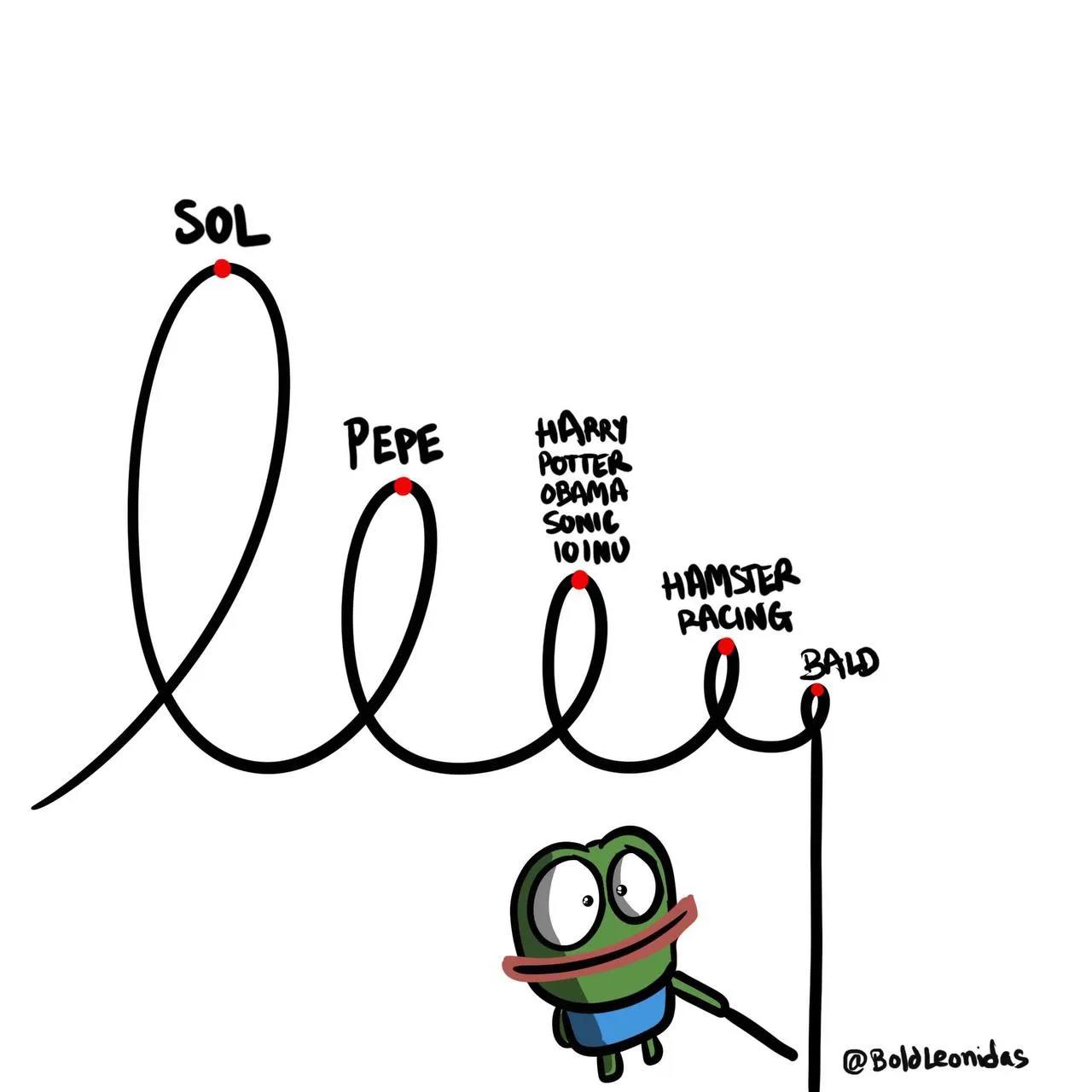
In the past week, I made an observation. You can invest in Axie Infinity at the beginning of the gaming trend, then leave, and come back to find that your returns are higher than most Web3 game investors. The price of Axie once dropped to $0.14, but now it has risen to $6, with a return rate of 40 times.
- How does demand-driven affect the valuation of cryptocurrency assets? Re-examining BTC, ETH, and TRON
- DeGods trading volume surged, but the floor price was slashed. What happened after the release of the third quarter NFT?
- If ETH-Layer2 already exists, why do we need Alt-Layer1?
Its peak has exceeded 1000 times. The reason is that most seed-stage investment projects in Web3 games are either far from liquidity or may fail before raising more funds in the current market environment. But there are some flaws in my thinking:
- Seed-stage investment projects should not achieve returns within a time frame of 18-24 months.
- I assumed that investors would allocate funds to Axie Infinity when the game was still an unnoticed narrative.
However, the underlying logic remains that you can invest funds in a liquid asset during a bear market and achieve better returns than in early-stage risk investment transactions in that narrative. This problem has led me to think about the risk scope in cryptocurrencies and how attention precedes risk investment in our industry. This article summarizes my thoughts on how narratives drive capital and attention in our industry.
Before we begin, let’s look at some numbers. According to the data product I use for tracking, out of over 3500 tokens, nearly 1300 had less than 10 wallet transfers in the past month. According to DappRadar’s tracking of 14,000 dApps, less than 150 had 1000 users. In this industry, our focus quickly shifts from one asset to another. We also have similar confidence issues with fundraising mechanisms. The data below shows the number of mentions of ICOs and issuance platforms in well-known cryptocurrency communities over the past few years.
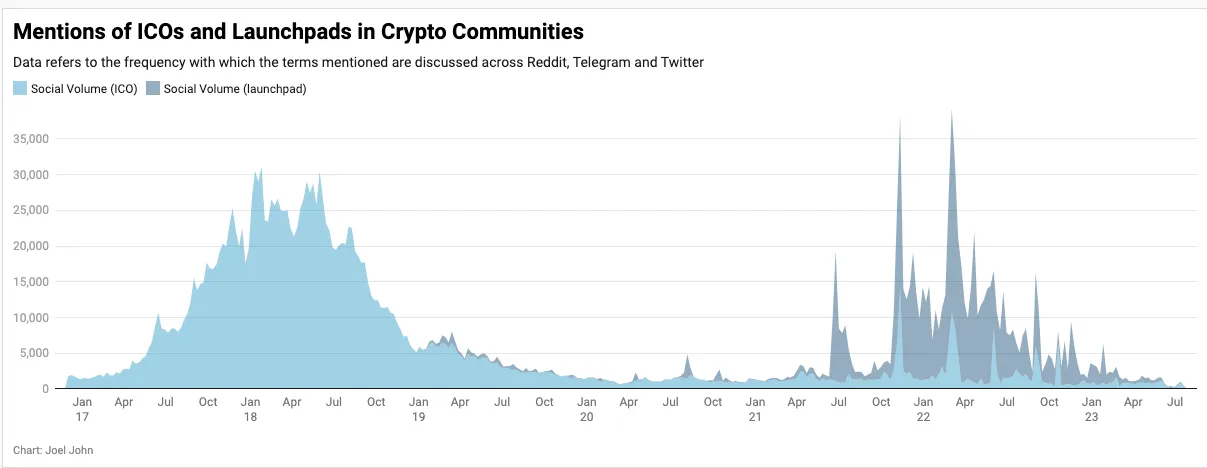
If you were in the circle back in 2017, you might think that risk investment will change forever. Many of the startups that raised funds in that market no longer exist. According to data sources, cryptocurrencies raised between $19 billion and $60 billion from retail and institutional participants that year. However, the survival rate of those ICO projects is comparable to what we traditionally see with startups.
You can see the results between January 2019 and January 2021 in the chart above – the golden age of cryptocurrency risk investment. Interest in ICOs quickly faded. Investors saw an opportunity in a brief period when those dream-driven founders could no longer obtain retail capital for development. Startup valuations ranged from $5 million to $10 million. Founders and investors had to collaborate again to survive.

The reason why founders turned to VC to raise funds is partly to better understand the risks of early token issuance. You must spend time managing the community, doing legal work to ensure compliance, and linking your net assets to a liquid asset while running a company. Founders may get annoyed by someone’s comments about team members on Discord and decide to sell all their tokens on an exchange with only $10,000 in liquidity, resulting in waking up 20% poorer.
Years later, we are back in the season of LaunchLianGuaid – exchanges playing God and deciding which venture capital projects can get millions of dollars from retail investors. Although there are many barriers this time, at least they ensure that retail investors get better conditions in terms of investment than the billions of dollars valuation seen in the 2017 ICO.
I chose how ICOs gave way to LaunchLianGuaid as a case because there is relevant data. Enough years have passed since the ICO boom for us to understand what happened afterwards. If you look at some of the more recent topics, such as DeFi, NFT, or Web3 games, you will find that public interest in them has completely disappeared.
But unlike ICOs, the stories of DeFi, Web3 games, and NFTs are still evolving.
The fading narrative
DeFi has transitioned from a peak of over-expectation to an enlightenment stage. Uniswap competitors did not emerge. Aave and Compound have dominated the lending market (targeting spot and over-collateralized assets). The continuous iteration of these products will be more consumer or institution-oriented and no longer overly obsessed with speculation.
Robert Leshner shifted his focus to launching a mutual fund, while Stani turned to Lens (Web3 social), showing how those founders who have been in the industry are preparing for the next round.
Google search trends, TVL, and user numbers are good indicators to observe the attention and capital flow in DeFi. As of now, the funds on DeFi platforms have dropped from a peak of $160 billion to a low of $40 billion.
If you look at the data on user numbers, they have decreased by 50% in the past few months. But compared to when DeFi Summer started in March 2020, the number of users has still grown 100 times.
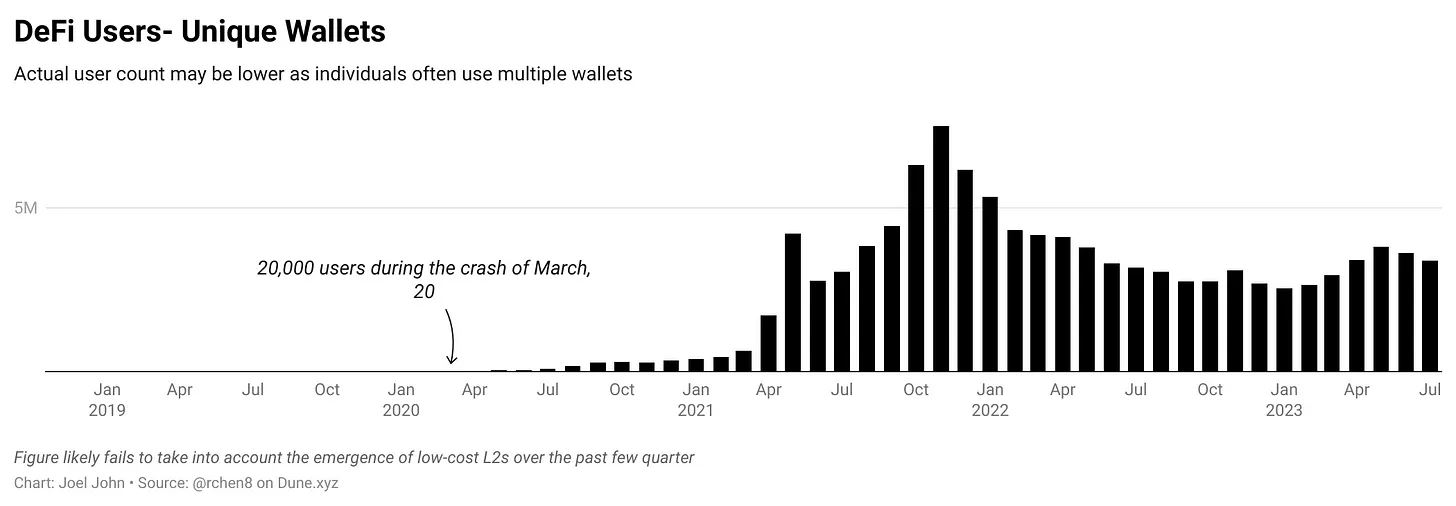
In other words, although interest and usage have decreased, the number of users in these product categories is still much higher than before. However, if you look at the search trends for the same functionality, you will see a completely different story.
Interest has returned to the bear market levels of 2018. It’s as if no one cares about this industry anymore. I looked at the data for NFTs and ChatGPT, and they both show similar trends. The search trend for aliens is on the rise. (Maybe we need to start investing in alien services.)

Based on this DeFi data, I have a few observations:
- Narratives build up momentum at the start of a bull market.
- They are usually driven by technological developments.
- Early adopters in specific areas have received excess returns due to the expansion of narratives and usage.
- Compound, UniSwap, and Bored Apes are all examples of narratives combining with product usage to bring excess returns to investors.
The challenge is that you have to invest in narratives that may disappear before they attract enough users. We may need to go back to Axie Infinity to sort things out.
Seizing the right timing

The reason I’m going back to Axie is because it covers several themes well.
- By 2021, Axie had already launched and had about 2 years of product development.
- It can be said that it was undervalued at the time.
- Axie marked the beginning of the Web3 gaming theme.
It’s important to note that this is not an evaluation of Axie. I’m optimistic about what the team can do, and we’ve been internally researching arguments about Web3 gaming. I’m still a loyal fan of Sky Mavis and the work they’ve done for consumer-grade blockchain applications. Our focus is on price and user activity.
If you pay attention to the chart above, you’ll notice that there was a large influx of users before Axie’s price surged to $150. On-chain researchers likely saw the extent of new user influx into the product and priced it well before July 2021.
But by October, when the number of new users started to decline, Axie became more like an asset than a product. This is a trap that all on-chain products easily fall into. The hyper-financialization of in-game assets means that hedge funds in New York can pay guild members who are striving in the game. The pattern of earning in-game revenue depends on the inflow and liquidity of in-game assets. Sometimes, this liquidity comes from speculators and institutions.
Between July 2021 and January 2022, many investors formed beliefs while observing and wrote papers on how the industry would develop. Founders also realized the challenges in building DeFi dApps and believed that gaming was the next big trend, just as many founders are getting into artificial intelligence today.
The real risk lies in the 18 months after January 2022. Do you see the steady decline in the number of new users in the chart above? This is the shrinking user base of all Web3 native gaming applications. Tools built on the edge, such as “Web3 games on Steam,” will soon struggle to find users.
This misunderstanding of short-term price increases and actual consumer demand is a trap that many founders fall into. The risk for founders is that without appeal, it is difficult to secure follow-up financing in the current market environment.
Founders are likely to miss the right timing in the right market. The danger for founders is to shut down the business before enough attention or capital flows into the category.
As a venture capitalist, on one hand, you will see the liquid market offering huge returns to traders, and on the other hand, you will be competing with a group of founders who are also venturing into this theme. This is not a pleasant experience for any participant.
My viewpoint is:
- Markets usually price narratives in the short term.
- Given the liquidity nature of Web3 investments, liquid assets may exit within a quarter.
- Given the illiquid nature of venture capital, when a product goes live, startups may not have a market to tap into as the product takes time to develop.
- This often leads to a slow death and a gamble on user return. The product effectively becomes a bet on “bull return.”
The exception is when a category expands to have a sufficient number of interested users and you build something unique. Ironically, DeFi has already crossed the chasm. With a scale of 3 million users, DeFi founders building no longer worry about new users entering the market.
Crypto-native investors who engage in venture capital are either appreciators or pioneers. They either have the distribution and influence to pioneer a new category or have foresight to see a completely new industry emerging. If they rely solely on price action as a driving force to make new arguments, then they are entering the market very late. They are likely to miss exit opportunities unless it is a business that can scale to an IPO or be acquired. Both of these cases are rare in the token field.
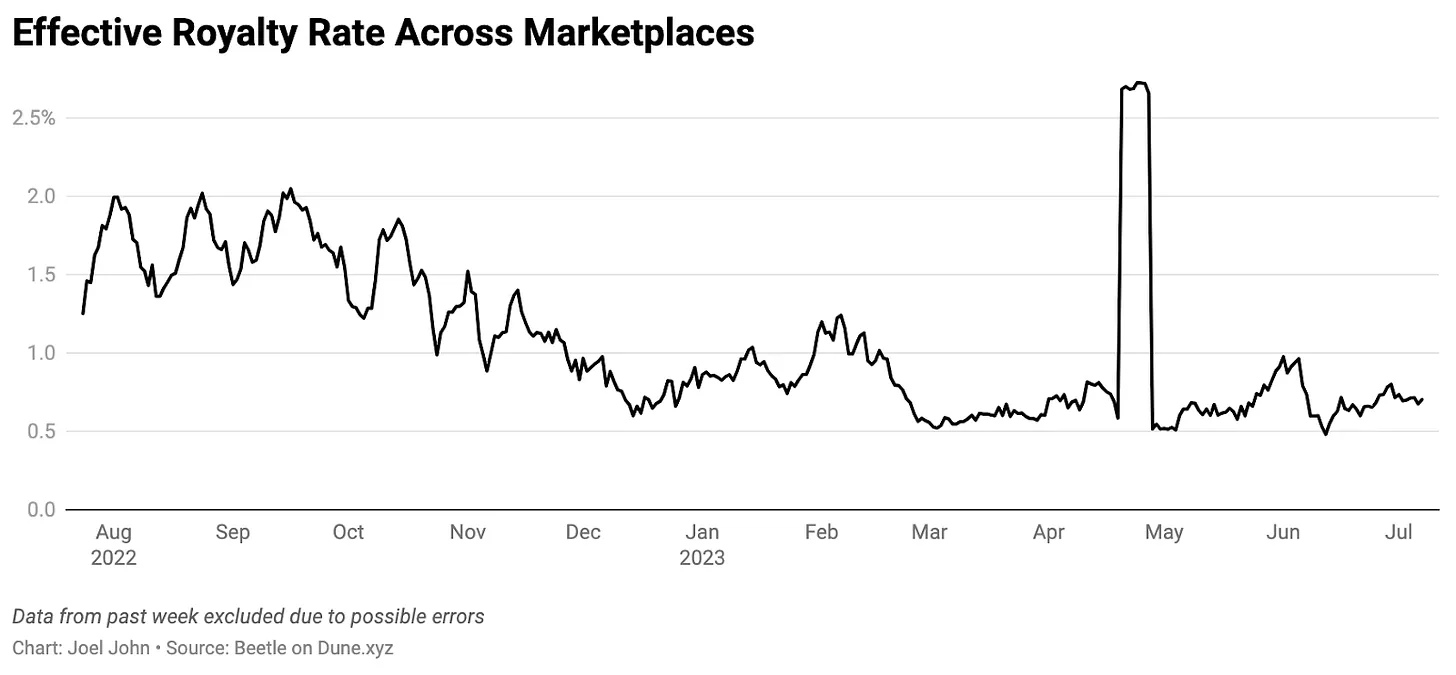
Another way that impacts founders is the evolution of business models. For example, due to the emergence of royalty-free markets like Blur, the effective royalty rate for NFTs has dropped from about 2.5% to 0.6% last year. As of writing this article, about 90% of NFT transactions do not charge any royalties.
Essentially, this means that any enterprise based on the idea that a large number of traditional artists will enter the industry will completely disappear, and they in turn will need tools to generate income. Last year, countless creator economy businesses had to pivot as the landscape shifted.
For all emerging technologies, chaos is a way of life in the crypto world.
Free
Let’s take a step back and go back to the late 2000s. After spending a long day at school, you log into Facebook to chat with friends. There are countless interesting videos on YouTube. Advertisements are spread throughout these activities, but you rarely pay a penny for them. The internet has formed the habit of being free before you pay for it.

In contrast, the obsession with ownership and monopoly in Web3 has created small user communities. According to their blog, Arkham Intelligence has over 100,000 users. Nansen’s V2 product has registered over 500,000 users today. Dune has one of the largest communities of data scientists in the industry. The only thing they have in common is that they’re free.
The genius of the internet is to allow users to bear most of the costs of their actions. In return, it gains influence. The big danger of Web3 is how high the cost is for each interaction. For users who don’t need online socializing, it’s not appealing to spend $8 to buy an image on the blockchain.
Why would users who have had an email address for free for decades spend $50 to buy ENS? Axie Infinity initially required spending $1200 to buy NFTs to play the game. The guild mode relies on this high threshold. Last year, they released a free version to play, realizing the danger of maintaining this high threshold.
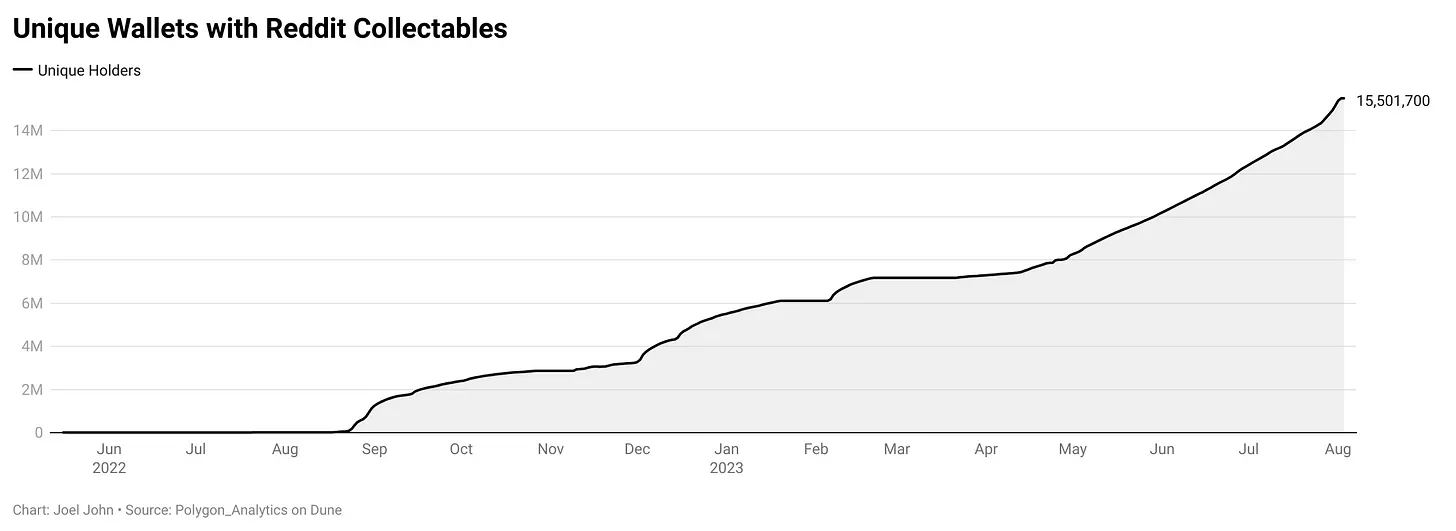
Today, Reddit combines this “free” and “ownership” very cleverly. As a social network with 400 million monthly active users, Reddit is a giant. So far, about 15 million wallets have collected their collections. This is roughly double the number of DeFi users in peak months. Accounts with specific years and features are allowed to purchase collections from Reddit.
In this case, most users still use “free” products, and only a small percentage of users forge, trade, and own collections. Distribution is solved through a website that has been running for 18 years.
Rabbithole and Layer3 fit this pattern very well. They don’t charge users, but provide value to those curious enough to explore new opportunities on the chain. According to a tweet from the founder of Layer3, the product has provided about 15 million on-chain operations for those interested in cryptocurrency.

A shift in product strategy is happening. If you visit Beam.eco, you will see a wallet set up in less than 10 seconds. Asset.money helps you collect NFTs with less than three clicks. Users don’t have to worry about gas fees, entry points, or setting up wallets. Of course, there are security trade-offs. This is similar to the transition of email from everyone running their own servers to third-party servers operated by service providers like Hotmail and Google.
Counter Sales Trade
Remember when I said that narrative alone cannot determine the timing of crypto venture capital? The way to escape this trap is the oldest trick in the book:
- Attract and maintain a user base over the long term;
- Accumulate value steadily over a long time frame.
Some tokens in the industry have already succeeded in doing this. When it comes to the DeFi field, I think of Uniswap. Despite attacks on royalties, OpenSea still remains relevant. The tail end of venture capital is a big gamble on how and when attention and capital flow.
The only way to break free from an unhealthy dependence on investor or speculator capital is to leverage the purest form of capital that all companies can access, which is the attention of their customers. As venture capital tightens, more and more startups (and protocols) will have to find users who care about their products.
The most relevant example I found is Manifold.xyz. The product focuses on helping creators mint NFTs relatively easily. According to TokenTerminal data, their fees exceeded $1 million last month. Is it performing well? Maybe not. Is it relevant in the current market? Absolutely.
I found a common thread among many participants who have successfully weathered market cycles, and that is their first-mover advantage. It’s a recurring story.
A small team enters an industry when market sentiment is at its peak. They see the market gradually shrinking. Usually, fewer than five participants are willing to continue building when the competition is leaving. When attention and capital return, they are the most likely to scale. From this perspective, as long as you can survive, the narratives that big investors give up on are the ones you should participate in.
Joining Web3 was “cool” some time ago, now mentioning that you work in this industry may be embarrassing. Teams feel the need to fabricate statistics to maintain relevance. We often see founders exaggerating their products by driving trading volume through airdrops.

For founders, this is a survival memo.
- Understand the difference between VC betting on narratives and VC that deeply explores your sector.
- Early entry into the market itself is a moat. But it also means that it will take several months or longer for someone to believe in your product. Most of your marketing will become an investor education course. This is both a blessing and a curse.
- In a market where all peers are going under, survival is the ultimate game. Keeping expenses to a minimum for survival is usually the right approach.
- Consumer attention often precedes investor funding. Engaging with users before pitching to investors helps iterate on the product.
- If product-market fit cannot be found within a meaningful timeframe, it is meaningful to end the business.
Given that the cryptocurrency market is a highly liquid market, investments (time or money) need to understand which stage of the narrative they are in. The trap often lies in spending years on a collapsing sector. Personally, I don’t believe that the Web3 game is over. Its story is still being written by countless founders who still have faith in this sector.
The trap lies in confusing the price behavior of the public market with investment opportunities in the private market. By the time a product is listed, the narrative may already be dead. Follow-up funding may disappear. Consumers may not care. This is a tough battle that many founders will have to face in the coming quarters.
Like what you're reading? Subscribe to our top stories.
We will continue to update Gambling Chain; if you have any questions or suggestions, please contact us!